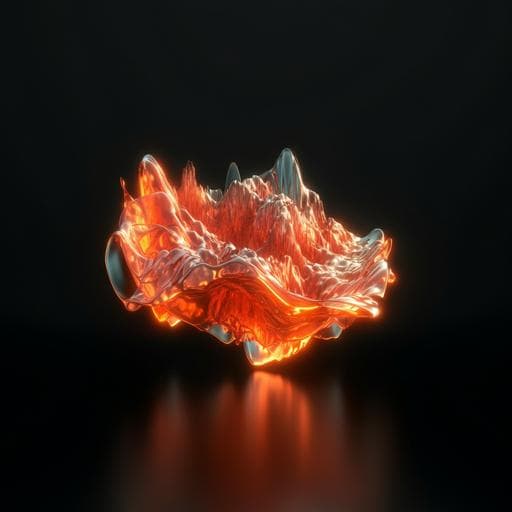
Physics
Single-shot ultrafast terahertz photography
J. Dong, P. You, et al.
Discover the groundbreaking advancements in terahertz (THz) photography achieved by Junliang Dong, Pei You, Alessandro Tomasino, Aycan Yurtsever, and Roberto Morandotti. This innovative system captures ultrafast scenes with sub-picosecond resolution, unlocking new possibilities for observing non-repeatable events in optically opaque materials.
~3 min • Beginner • English
Introduction
Single-shot ultrafast photography has emerged as a key technique to elucidate complex ultrafast phenomena, enabling capture of two-dimensional transient scenes at up to 100 billion frames per second, sufficient to visualize light-in-flight. Such capabilities have transformative potential for observing non-repeatable or destructive events (e.g., explosions, laser chaos, irreversible chemical reactions) where conventional pump–probe methods fall short. However, previous single-shot ultrafast imaging demonstrations have been confined to optical wavelengths, limiting applicability to optically transparent media. Many important ultrafast processes in materials with short optical penetration depths (e.g., laser ablation in ceramics, magnetization dynamics in iron films, carrier excitations in semiconductors) remain inaccessible. Terahertz (THz) imaging has attracted strong interest due to its ability to penetrate metals, semiconductors, and dielectrics more effectively than optical bands, while posing minimal risk to biological tissue due to low photon energy and offering spectroscopic specificity. Despite these advantages, single-shot ultrafast THz imaging has been hindered by the lack of high-speed THz cameras.
Literature Review
Prior single-shot ultrafast imaging has predominantly operated in the optical domain, achieving frame rates up to 10^11 fps and enabling studies such as light-in-flight, cloaking, and visualization of non-repeatable events. However, these techniques are unsuitable for opaque media. THz imaging offers deeper penetration, low photon energy, and spectroscopic fingerprints useful for probing thick, multilayered structures. Real-time and near-field THz imaging approaches using alternative detection schemes (e.g., single-pixel detection, atomic fluorescence, ultrafast THz STM, ghost imaging) have advanced the field but do not provide single-shot ultrafast multi-frame capture. Holography-based single-shot THz spatiotemporal field diagnostics have been proposed theoretically, but are experimentally challenging and limited to simple scenes (e.g., focused THz spots). Electro-optic sampling (EOS) is an established coherent technique to retrieve THz fields via THz-induced birefringence in Pockels crystals and can be mapped to CCDs through polarization analysis. Building on EOS, spatial-frequency multiplexing and structured illumination concepts from ultrafast optical imaging suggest a route to multi-frame capture without a THz camera.
Methodology
Concept: The system performs single-shot ultrafast THz imaging by multiplexing an 800 nm optical probe both temporally and spatially, and using EOS in a ZnTe crystal to map the THz electric-field-induced birefringence to an intensity image on a CCD. Spatial-frequency multiplexing uses Ronchi gratings with distinct orientations to encode separate frames into non-overlapping regions in Fourier space; temporal multiplexing uses optical delay lines to create sub-pulses probing at different times.
System design: An 800 nm, 150 fs Ti:Sapphire amplifier at 1 kHz provides pump and probe beams. THz pulses are generated by optical rectification in a 63°-cut LiNbO3 crystal using a tilted-pulse-front scheme (1800 grooves/mm grating), yielding a THz spectrum ~1.2 THz FWHM centered at ~0.5 THz. The THz beam is expanded and collimated (~2 cm diameter at 10% field peak) and relayed to the EOS crystal via TPX lenses. The probe is split into four equal-intensity sub-pulses via a beam-splitter tree; each sub-pulse passes through an independent optical delay line (minimum step 25 fs) and a Ronchi grating (20 lp/mm) at orientations 0°, 45°, 90°, 135°. Lenses form sinusoidal fringe patterns by collecting ±1 diffraction orders. Sub-pulses are recombined to produce a multiplexed probe with four temporal delays and four spatial modulations. EOS is implemented in a 1-mm ZnTe <110> crystal with a quarter-wave plate and polarizer; detection can be co- or counter-propagating depending on experiment. The CCD (pco. pixelfly, 1392×1040 pixels, 14-bit, 6.45 μm pixel) records the multiplexed image; polarizer is set to capture bipolar THz transients. Estimated spatial resolution is ~0.56 mm (set by THz central frequency). Inter-frame intervals are flexibly set by delay lines; four frames demonstrated, expandable with more beam splitters and delays (limits discussed in Supplementary Information).
Imaging model: EOS intensity P(x,y,t) ∝ I0(x,y,t) L n0(ω) r41 ETHz(x,y,ωTHz,t), where THz-induced birefringence modulates probe polarization. With temporal and spatial multiplexing, the probe intensity is I(x,y,t) = Σn In(x,y,t−Δton) Mn(x,y), where Δton are sub-pulse delays and Mn are grating modulation patterns (modeled as periodic square waves). In Fourier space, multiplication by Mn produces shifted spectral copies of each frame at spatial frequencies determined by grating period T and orientation θ (kx shifts by multiples of k0=2π/T). Thus, the CCD-recorded multiplexed image comprises a superposition of distinct, non-overlapping spectral copies of each frame.
Post-processing: 1) Compute 2D Fourier transform of the multiplexed CCD image. 2) Isolate one image copy via a spatial-frequency band-pass filter (rectangular window; width chosen to balance spatial resolution and crosstalk—80 pixels for light-in-flight, 140 pixels for carrier dynamics). 3) Shift the isolated spectral content to the origin to convert sinusoidal modulation to uniform illumination. 4) Apply inverse Fourier transform to recover the frame. Repeat for each spectral region to reconstruct all frames.
Experimental configurations: Light-in-flight experiment used counter-propagating EOS to shrink the THz image onto the ZnTe area (TPX2 f=100 mm; TPX3 f=35 mm; L1 f=250 mm; L2 f=500 mm). Carrier dynamics experiment used co-propagating EOS (TPX2 f=100 mm; TPX3 f=65 mm; L1 f=200 mm; L2 f=250 mm). A near-infrared pump (from the main pump via 90/10 splitter) with independent delay excited carriers in silicon for the second experiment.
Key Findings
- Demonstrated single-shot ultrafast THz photography capturing multiple frames with sub-picosecond temporal resolution by time- and spatial-frequency multiplexed EOS and computational demultiplexing.
- Light-in-flight through opaque Teflon: A THz pulse propagated through a 2-mm-thick Teflon sheet engraved with letters T, N, R, S at depths 2.0, 1.5, 1.0, and 0.5 mm, respectively. Four frames were recorded with inter-frame intervals of 0.75 ps, probe arrival time set to 3.90 ps relative to the THz reference. Recovered frames showed the expected sequence of transmission (T → N → R → S), confirming that the THz pulse first passed through the fully engraved letter. Temporal shifts of ±0.70 ps produced corresponding time-lapse frame sequences, validating temporal gating and reconstruction. The image contrast corresponds to the THz electric-field amplitude.
- Carrier dynamics in silicon: Photoexcitation induced a decrease in THz transmission due to carrier generation, persisting for ~6 ps until full excitation in the illuminated area. To enlarge the imaging time window, a 35-μm Si wafer was attached to mirror M1, producing a multi-cycle THz pulse. Four probe sub-pulses were aligned to four THz peaks with inter-frame intervals of 0.75 ps (Δt1), 0.75 ps (Δt2), and 1.35 ps (Δt3). A representative set captured at 1.25 ps after photoexcitation was reconstructed; contrast was the modulation ratio normalized to a reference frame at 26 ps (fully excited carriers). Frames showed carriers excited from left to right due to oblique pump incidence. Additional sets with pump arrival shifted by ±1.20 ps corroborated the spatiotemporal evolution.
- System performance and parameters: Temporal resolution is sub-ps and limited by the 150-fs probe pulse. Inter-frame spacing is tunable via delay lines. Spatial resolution ~0.56 mm (set by ~0.5 THz central frequency). THz spectrum ~1.2 THz FWHM. CCD acquisition captured multiplexed images whose frame spectra were well separated in Fourier space, enabling low-crosstalk recovery.
Discussion
The work addresses the lack of single-shot ultrafast THz imaging by replacing a high-speed THz camera with a multiplexed near-infrared probe and EOS detection, thereby enabling capture of non-repeatable ultrafast events in optically opaque media. Spatial-frequency multiplexing ensures that overlapping frames in real space remain separable in Fourier space, allowing computational demultiplexing with controllable trade-offs between spatial resolution and crosstalk. The light-in-flight experiment validates accurate temporal sequencing and field-sensitive contrast, while the silicon carrier dynamics experiment demonstrates sensitivity to ultrafast material responses and the flexibility to tailor the imaging time window via THz pulse engineering. The approach is compatible with spectroscopic THz imaging and could be extended to hyperspectral modalities, offering a pathway to study complex dynamics in multilayered structures and functional materials inaccessible to optical imaging.
Conclusion
A single-shot ultrafast THz photography system was presented that captures multi-frame ultrafast scenes in optically opaque scenarios with sub-picosecond temporal resolution. By multiplexing an EOS probe in time and spatial-frequency domains and reconstructing frames via Fourier-domain filtering, the method records the spatiotemporal evolution of THz fields and material dynamics without a high-speed THz camera. Demonstrations included light-in-flight through a patterned Teflon structure and femtosecond photoexcited carrier dynamics in silicon. The inter-frame interval is easily tunable; temporal resolution is governed by probe pulse duration. The technique can be adapted for higher spatial resolution using near-field configurations, enabling single-shot ultrafast THz microscopy by placing objects directly on the detection crystal. Future work may extend frame count, integrate hyperspectral capability, and target advanced materials (e.g., 2D materials and biological matter).
Limitations
- Temporal resolution limited by the probe pulse duration; inter-frame intervals smaller than the probe duration cause interference between consecutive sub-pulses, introducing spurious frequency content and degrading frame recovery.
- Spatial resolution limited by the THz wavelength/central frequency (~0.56 mm in this setup); improvements require near-field configurations or higher-frequency THz sources.
- Frame count is practically limited by available non-overlapping spatial-frequency regions and system complexity (additional beam splitters/delays), as discussed in the Supplementary Information.
- Trade-off in post-processing filter width between preserving spatial detail and avoiding crosstalk among adjacent spectral copies.
Related Publications
Explore these studies to deepen your understanding of the subject.







